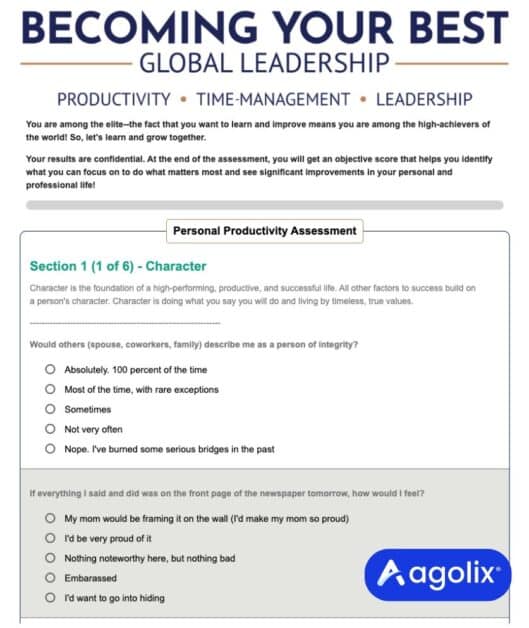If you run your own business, or work in coaching or education, you’ve probably heard the terms ‘assessment’ and ‘evaluation’ tossed around. Let’s be honest- they sometimes sound like the same thing, and are fairly easy to mix up!
Below, we’ll explore the differences and similarities between assessments and evaluations, how each one works, and how you can use them (sometimes together!) to improve performance, measure progress, and drive meaningful change in your business.
What Are Assessments and Evaluations?
Before we jump into the details, take a moment to really picture your business needs. Are you a coach looking to streamline your intake process? Are you the owner of a marketing agency looking to give feedback to your small but mighty team? Maybe you’re an educator who needs to assess a student’s progress.
If you have something in mind — great! If not, hopefully reading some definitions and examples below can help clarify what assessments and evaluations really are and how they can provide the most value for you and your business.
What Is an Assessment?
An assessment is a tool that gathers data, offers feedback, and guides development. It’s less about judging someone and more about helping them grow. Here is an example of a sample assessment that you can customize for career coaching or use to measure job satisfaction:
Key Characteristics of Assessments:
- Diagnostic or exploratory in nature
- Offers personalized feedback
- Encourages reflection and growth
- Can be repeated and adapted over time
Examples:
- Coaching intake quizzes
- Personality style questionnaires
- Leadership skill check-ins
- Diagnostic tests in education
In short, assessments engage, inform, and develop. You can use assessments at the beginning of a journey — likes when you onboard a client — to measure progress and offer tailored guidance.
What Is an Evaluation?
An evaluation measures or judges performance against a set of criteria. It’s more structured than an assessment, and often tied to specific outcomes.
Key Characteristics of Evaluations:
- Concludes or reviews a process or program
- Provides objective data or scoring
- Tied to key performance indicators (KPIs) or outcomes
- Helps drive decisions or improvements
Examples:
- Employee performance reviews
- Program success tracking
- Academic grading
- Business audits
Evaluations typically come after a newly implemented initiative, offering a snapshot of success or providing clarity on where things went off track.
Purpose of Assessments and Evaluations

Now that you’ve read the definitions and thought about potential use cases in your business, it’s time to start seeing where and when to use an assessment vs an evaluation.
Why Use Assessments?
Assessments are fantastic for opening up conversations, understanding where a client is starting from, and offering personalized feedback that helps guide their next step. People who identify with the types of businesses below may find assessments more useful:
- Coaches and consultants assessing client readiness or mindset
- Educators checking student understanding
- Business owners capturing lead preferences or behaviors
Assessments are a great way to offer value upfront while simultaneously collecting helpful data. For example, Right Management Research found that managers were 4.8 times more likely to focus on retaining top-rated leaders after using leadership assessments, and 68% of hiring managers reported that assessments improved their hiring decisions.
Why Use Evaluations?
Evaluations help decision-makers understand what worked and what didn’t. Primarily rooted in data, they help measure the success of a person, program, or process. Teams that use them most include:
- HR teams measuring employee performance
- Program managers assessing effectiveness
- Academic institutions evaluating curriculum outcomes
Evaluations bring structure to reflection – whether that’s after a campaign, quarter, or year.
Assessment vs Evaluations: 4 Key Differences
Still unsure about the difference between assessments and evaluations? Perhaps this chart below from the National Institute for Learning Outcomes will help. It shows the separate, unique features of assessments and evaluations, with the overlap in the middle.
Along with the context above, here are some key differences across each, and why you should care about them:
1. Intent: Growth vs. Judgment
An assessment is focused on growth, improvement, and feedback and its core. It’s designed to help someone learn more about themselves and foster greater self-awareness. If you’re a coach, consultant, or educator, assessments help you to shine a light on where a client is starting from, so you can better help guide their development progress and journey.
Meanwhile, an evaluation focuses on judgment and accountability. Evaluations help to answer the question of whether or not a person or program met expectations and set standards. Examples of this include students taking a final exam, or an employee being reviewed for a promotion.
2. Timing: Ongoing vs. Final
Assessments have the most use at the beginning of a relationship or project, and at various checkpoints along the way. For example, if you’re onboarding a new client, you might use an assessment to evaluate their baseline skills or pain points. This information then helps you to tailor your strategy and feedback as they grow, and creates stronger client relationships.
With an evaluation, you are primarily measuring an outcome at the end of a process or program. Think of an evaluation like a final wrap-up or post-mortem meeting. One example is a teacher giving a test at the end of a quarter to see how much information students retained, or an HR professional doing something similar based on a workplace training module. Evaluations provide clarity and closure, helping you to decide what is working, and where improvement is needed.
3. Format: Adaptive vs. Standardized
Assessments are adaptable, offering flexibility and customization that can reach respondents in a more personal way. You can tailor your assessments to specific goals and audiences, and design it based on those needs. Whether you’re working with creatives or accountants, you can design an assessment with the formatting, language, and details you need.
Evaluations tend to be more fixed and rigid in their design and content. Think of things like standardized tests, or structured performance reviews. The main goal of an evaluation is consistency in measurement of everyone or everything, and fairness in comparability.
4. Output: Feedback vs. Score
The output of an assessment is like a mirror being held up to your client, which shows them insights and recommendations for improvement. This is a huge value-add for coaches and business owners, as it lets you create opportunities for transformation that you can help facilitate!
The output of an evaluation is usually a number or rating; some type of final measurement. The information gathered is less about feedback and a conversation, and more about closing a chapter. For example, after a 3-month coaching engagement, you run an evaluation to document a client’s progress towards specific goals and if they were met.
Similarities Between Assessments and Evaluations
Despite their differences, these two tools do share some common ground:
- Data-driven: Both rely on collecting and analyzing information
- Stakeholder involvement: Both require input from participants
- Outcome-focused: Both aim to improve performance and guide decisions
Visual Comparison Table: Assessment vs. Evaluation
| Aspect | Assessment | Evaluation |
| Purpose | Growth and feedback | Judgment and measurement |
| Timing | Ongoing or preliminary | Final or after completion |
| Format | Flexible and personalized | Standardized and structured |
| Output | Feedback, recommendations | Scores, grades, performance ratings |
| Audience | Individuals or small groups | Programs, teams, larger populations |
How Assessments and Evaluations Work Together
Here’s the cool part: you don’t have to pick just one. In fact, they often work best together! According to a 2022 report by the Society for Human Resource Management (SHRM), businesses that use both skills assessments and performance evaluations show a 24% increase in employee productivity and engagement.
Start with an assessment to understand needs or knowledge levels. Follow with an evaluation to measure the results after a learning or development phase.
So when and how should you use both?
- Employee onboarding: Start with a skills assessment when someone is hired, which will help with tailoring onboarding plans and future employee success. After a few months on the job, finish with a 90-day performance evaluation to show progress made towards the outlined expectations This way, the employee has time to get their footing and make progress from their original assessment.
- Course design: Before a course starts, begin with a pre-course assessment on the specific topic to gauge the basic knowledge of participants or students. This gives you valuable information as an instructor to adjust content as needed. Then, you can conclude with an end-of-course exam to measure retention and learning outcomes.
- Coaching programs: Use assessments for the onboarding and intake of new clients to create a baseline understanding of where they are now, and what their goals are. Then, follow up with a program evaluation at the end of the coaching period to close out a client’s progress and provide concrete measurements on the progress made.
How to Choose Between an Assessment and an Evaluation

Here’s a quick framework to help in your decision-making:
- If your goal is ongoing feedback, choose an assessment.
- If your goal is to measure final results, go with an evaluation.
- If you want to do both – use them at different stages of your process!
One isn’t better than the other; it simply depends on your objective. Both tools are essential – and they shine in different ways. Assessments help you to understand, engage, and guide, while evaluations measure, analyze, and optimize.
Need to improve your outcomes? Use both strategically, and you’ll make smarter decisions, every step of the way.
Types of Assessments and Evaluations
Whether you’re coaching a client through personal transformation, managing a team, launching a new program, or teaching a room full of students, assessments and evaluations can help you do it better. There are different types of assessments and evaluations, each designed for a specific stage in a person or program’s journey. Some are great for identifying needs and making mid-course corrections (like diagnostic and formative assessments), while others are best for measuring effectiveness, performance, or compliance (such as audits and performance reviews).
How do you know which one to use? If you’re a coach or course creator, use diagnostic assessments to personalize your approach, and program evaluations to gather valuable feedback once your offering wraps up. If you’re a business owner, tools like performance evaluations and self-assessments can help you build stronger teams and more effective training programs. If you’re in education or employee development, a mix of formative assessments and audits can keep both your learners and your systems on track.
Let’s dive into them all in some more detail below!
3 Common Types of Assessments
- Formative Assessments: Formative assessments are ongoing checks used during a learning or development process to monitor progress and make real-time adjustments. For example, a teacher might use quick in-class quizzes or polls to gauge how well students are grasping the material before moving on to the next topic.
- Diagnostic Assessments: These are typically used at the start of a program or session to identify a participant’s existing knowledge, skills, or learning gaps. For instance, a dance instructor might begin the school year by having students perform a few routines to determine which steps they already know and where they need extra support.
- Self-Assessments: Self-assessments allow individuals to reflect on their own skills, attitudes, or behaviors. This can help build self-awareness and personal accountability. In educational or training environments, peer assessments can also be used to let participants give feedback to one another.
3 Common Types of Evaluations
- Program Evaluations: Program evaluations are used to measure the overall effectiveness of a program or initiative. For example, after running a 6-week coaching program, you might send participants an evaluation to understand what worked, what didn’t, and how they felt about the experience.(As a bonus, this gives you incredibly valuable feedback, in a less awkward way than asking for it face-to-face!)
- Performance Evaluations: Performance evaluations are structured reviews of an individual’s or team’s performance over a set period, often used in workplace settings. If you’ve ever had a yearly review at a traditional job, you’ve experienced this firsthand! They typically focus on metrics like goals met, job responsibilities, team contributions, and opportunities for growth.
- Audits: Audits are formal evaluations that focus on financial, operational, or compliance standards. Businesses often conduct audits to determine whether they’re staying on budget, adhering to regulations, or operating efficiently.
Common Misconceptions About Assessments and Evaluations
One of the most common misconceptions about assessments and evaluations is that they are the same thing. We hope by now you realize that isn’t true! Assessments are more about feedback, and evaluations are about judgement.
Secondly, as we learned above, sometimes you need to use both at the same time for the best results. In the workplace, this improves employee performance and evaluation scores. Where could you use both in your job to provide extra value to clients?
Finally, many people think assessments are just surveys. While they contain similar questions and formatting, assessments let you go a step further and provide valuable, tailored feedback that most evaluations don’t give either.
Use Cases for Assessments
Let’s say you’re a coach looking to use an assessment as a coaching intake tool to understand a client’s pain points as they transition to senior leadership. You can start by creating a personalized assessment during the onboarding process that includes questions about leadership style, mindset blocks, and their current challenges.
How does this help? Clients receive a custom report summarizing their leadership tendencies and potential blind spots along the way. Then, you as their coach can use those results to personalize their coaching journey and hone in on focus areas. This lets you tee up increased client satisfaction and retention by creating trust and a strong relationship from the start!
Other examples of use cases are lead generation quizzes to capture contact info, and checklists for onboarding employees.
Use Cases for Evaluations
The same logic applies to when to use an evaluation. One example is for employee performance reviews, which help with promotions and development plans. Let’s say you’re a fairly large company with 50 employees, and you conduct bi-annual evaluations of employees. These evaluations are structured to measure achievement of goals and KPIs, collaboration, and growth potential.
This is helpful in two ways:
- For managers: These evaluations provide concrete data to support decisions around promotions, raises, or additional responsibilities.
- For employees: They offer insight into how individual performance aligns with broader company goals, helping employees understand their value and areas for growth.
Similar types of evaluation use include curriculum evaluations to see how effective a school’s learning modules are for students. If you’re working within a nonprofit or business, program evaluations to track ROI, impact, and areas for improvement are another example.
Create Your Own Assessment or Evaluation
As you can see, assessments and evaluations are incredibly valuable tools to utilize across industries and business models. From consulting to entrepreneurship, within a large or small company, each has a place to better provide data and drive meaningful growth.
You can choose between various types of assessments and evaluations, and even use them together for optimal results where necessary. The possibilities are truly endless!
Ready to get started crafting your own assessments and evaluations? At Agolix, we help you create custom assessments and evaluations without the tech headache. We’ve got templates and tools to support your goals.
Explore Agolix today to build your own assessments and evaluations in minutes.
Have questions or ideas on how to use these tools? Drop them in the comments or reach out – we’d love to hear from you!






